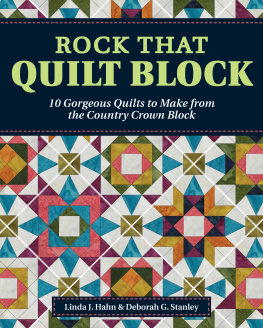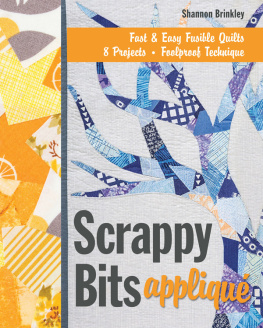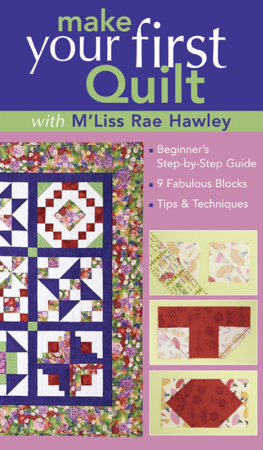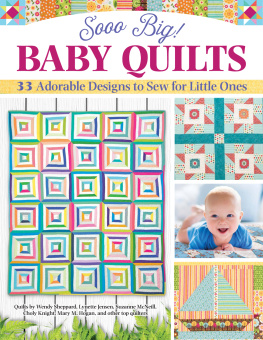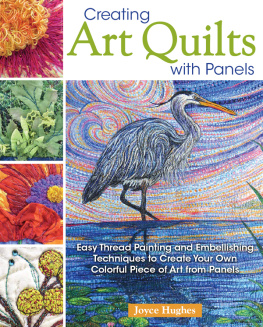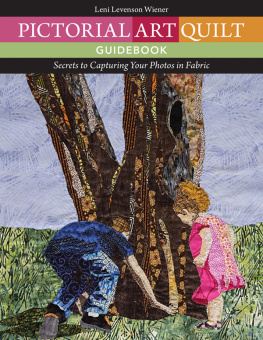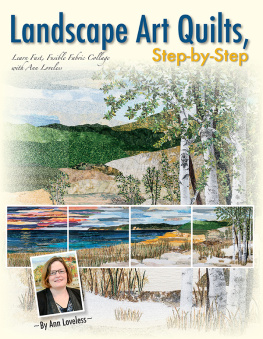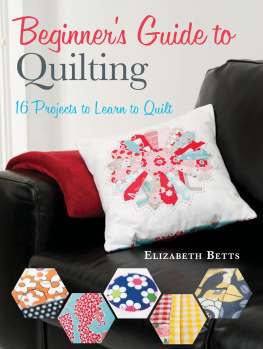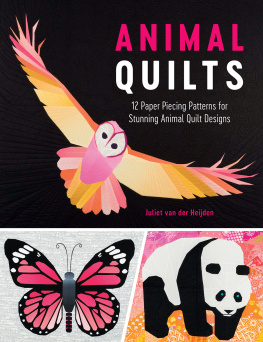ACKNOWLEDGMENTS
Many thanks go out to C&T Publishing for giving me the platform to write this book. Susanne Woods deserves special appreciation for her efforts to introduce me to the C&T team. I would also like to thank Diane Pedersen, Lynn Koolish, and all the other staff for giving me expert guidance through the publication process.
Deep affection must be expressed here to my mother, Ella, and father, James, for all of the sacrifices they made and love they gave me over the years.
I want to offer heartfelt appreciation and love to the rest of my family for their role in giving me the space and time to write this book. Many family members generously stepped up and made sacrifices so that I could dedicate myself to this exciting and challenging undertaking.
In addition, I am grateful to my students for their contributions to this book. I am so fortunate that the quilters who took my classes across the country and my talented architecture students at the Florida A&M University School of Architecture took a leap of faith and tackled the work you see in this book.
And last but definitely not least, heartfelt thanks and love to Bob, my dear husband. He was so encouraging and helped to photograph the work you see in this book.

introduction: mapping my beginnings as a quilt artist
I became interested in quilting quite by accident. I read an article in an academic journal that described a design project in which architecture students were asked to design a museum for quilts. Maybe the voice of my maternal grandmother, a home economics teacher, whispered to me as I read every word in the article. Perhaps it sparked a memory of learning to sew during hot and humid summers while on vacation at my grandmothers home in Tuscumbia, Alabama, during the 1960s. Whatever it was, I feel fortunate to have found the kernel of possibilities the day I read the article.
From that day onward, I began a journey that has taken me in many surprising and unexpected directions. It also created an interesting tensioncould aspects of quilting transfer to the way I teach architecture? The core question for me was, should a real architect quilt? Would I still be taken seriously as an architect? I received my architectural education in a male-dominated field in a male-dominated world. My exposure to the womens liberation movement during the late 1960s and 1970s created a feeling that quilting was somehow counter to the advancement of women in our society. There were all sorts of reservations spinning around in my brain. Deep down, though, I think I knew I might be onto something.
Despite these reservations, I plowed ahead with the determination I inherited from Mother Scruggs, my paternal grandmother. I thought about many things she instilled in me. She was a force of nature.

Mama Steele, my maternal grandmother
Photo by Valerie S. Goodwin
The next semester I created a number of design exercises for my beginning architecture students. They studied the design principles and elements seen in traditional patchwork blocks such as Nine-Patch, Flying Geese, and Log Cabin. As part of the project, they designed quilt blocks made from colored paper. The students then created small works of architecture that would display their quilt blocks.

Project by Donald Gray, architecture student, 1999
The students seemed to respond well to this unique way of learning about architecture and design. At times I now incorporate quilting into other architecture classes. Quilting is indeed like building; one constructs a quilt like one constructs an architectural design. Wherever I can, I weave ideas about art and craft into courses I teach across the curriculum.
LEARNING TO SEW AND QUILT
Many years earlier, I had abandoned my interest in sewing, partly in an effort to conform to peer pressure in high school. As I grew older, the desire to cope in a male-dominated profession left me with the feeling that working with bricks and mortar was a more noble goal than working with fabric and thread.
But fortunately, memories of the fun and satisfaction I felt when my grandmother taught me to sew spurred me forward.

Mother Scruggs, my paternal grandmother
Photo courtesy of Valerie S. Goodwin
I also thought about Cousin Hattie, who lived with my mothers family during the 1940s and 1950s. This remarkable woman made hundreds of quilts that she pieced during the summer and quilted during the winter. Many family members who are lucky enough to have her amazing quilts cherish her legacy. It was hard to ignore this deep-rooted heritage of working with fabric. These feelings and experiences prompted me to take a quilting workshop.
In 1998 I learned to quilt by enrolling in a six-week class in quiltmaking at a local community college. I made a sampler quilt totally by hand. It is hard to describe what this experience did for meall I can say is that it set off a series of light bulbs in my creative psyche. Shortly after this, a friend shared with me a copy of the 1999 Quilt National exhibit catalog. A whole world of possibilities was revealed! From then on, my goal was to discover how I could combine my love of architectural design with the medium of quiltmaking. The answer to my initial question is overwhelmingly apparent: Yes, real architects can and do quilt!
mapping out ways of working

SOURCES OF INSPIRATION
As with many artists, I am influenced by so many thingsthe visual world has an abundance of inspiration. I have a passion for art, architecture, and mapsthe language of lines, shapes, and color captures my imagination. My map compositions reflect these varied interests.
I love to design maps of real and imaginary landscapes and cities. Aerial views, with their lines and shapes, intrigue me. Repeatedly I refer to books on quilts, art, maps, urban planning, and site design. Travel is definitely something I do when I can. I have a bucket list of famous places I want to visit one day, and it prompted me to make the following quilts, one of a real place (The Acropolis) and one of a place that exists only in my imagination (Unknown Regions I).

The Acropolis by Valerie S. Goodwin, 2007, 13 12.75, in the private collection of Deborah Cashett
Photo by Richard Brunck

Unknown Regions I by Valerie S. Goodwin, 2003, 10 15
Photo by Richard Brunck
I am always bookmarking interesting sites and maps on the Internet so I can find them again. When I find a map of a place that I am interested in, I spend time looking at it to think about what I like about it. Sometimes the lines interest me. At other times, the shapes or the colors, and even the topography, capture my attention.
Next page

